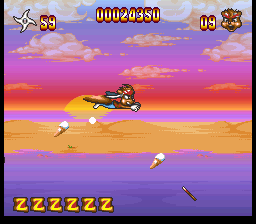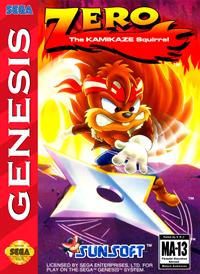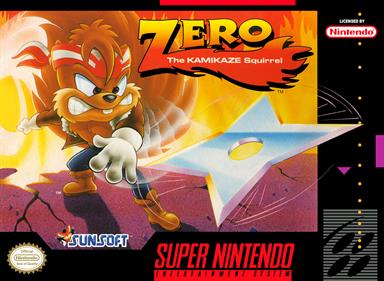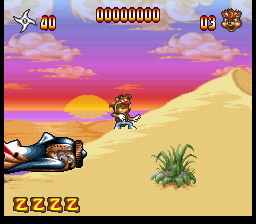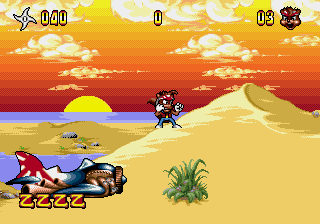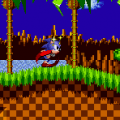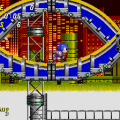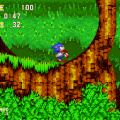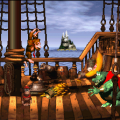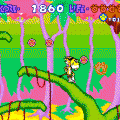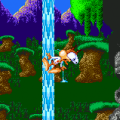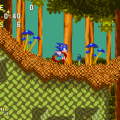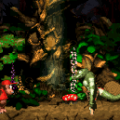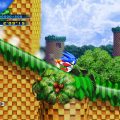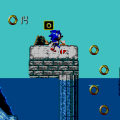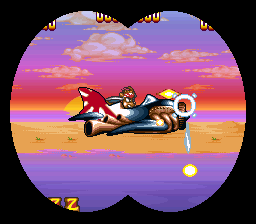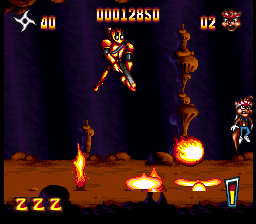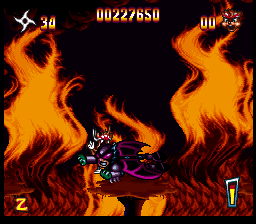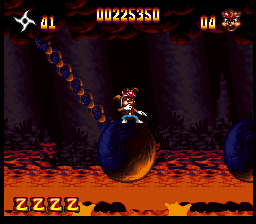- Aero the Acrobat
- Aero The Acrobat 2
- Zero the Kamikaze Squirrel
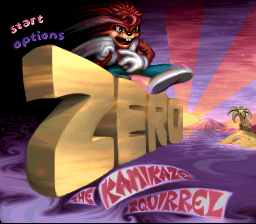
Zero is a fascinating anomaly, a game where one can’t help but wonder how exactly it happened. Seemingly released not too far from Aero 2, a cute, friendly platformer with a mascot wearing a big smile on his face, Zero couldn’t seem more different despite being part of the same series. The cover, featuring the hero tossing a shuriken at some unseen foe, a raging fire at his back, promises something very different indeed. Especially considering the MA-13 rating label featured upon the Genesis version’s cover, seen more often on games like Flashback. Even with Aero’s smiling face featured on the Sunsoft logo, one could be forgiven for not seeing the connection at all.
Zero the Kamikaze Squirrel himself made brief appearances in the original Aero, piloting various machines in an attempt to thwart Aero and swooping in at the end of the game to save his master. Despite only briefly appearing during the sequel’s opening cutscene, the ending mentions a quest he’s about to undertake to save his homeland, shown in full in this particular game. One could say that before games such as Shadow the Hedgehog and Jak II made it popular, Zero introduced the idea of the “mature, edgy” platformer that cropped up throughout the mid 2000s. It more than likely wasn’t the inspiration – despite good reviews in various magazines, it was never a game that seemed especially talked about. It wouldn’t be the first time the originator of an idea ended up being left behind, though.
Edgar Ektor’s henchman Zero receives a letter from his girlfriend Amy, informing him that an evil lumberjack has kidnapped her father and is chopping down their homeland forest. When Ektor refuses to let Zero return home, the squirrel sets off regardless – thus setting Ektor’s army against him on his journey to the forest. Aero himself only appears on the Sunsoft logo upon booting up the game, and doesn’t receive so much as a mention since. While the game only features cutscenes for its opening and ending, they serve well enough – with Aero 2 proving you didn’t need much more than that, anyways.
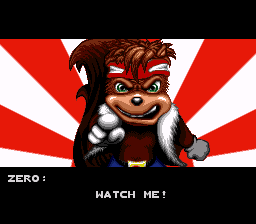
The game’s more intense tone is evident right from the start – as Zero flies over the beach in his plane, a burst of gunfire suddenly takes out its engine, forcing him to bail. While the Aero games featured costumed clowns and goofy Russian bears as foes, this game establishes itself as something else very quickly. Zero doesn’t throw magic stars, he has ninja stars. Robots blast at him with lasers and flamethrowers. Plants sometimes swallow him whole, spitting out his bones in a surprisingly violent fashion. Despite the colorful cartoon stylings, the danger in this world is real and ever present.
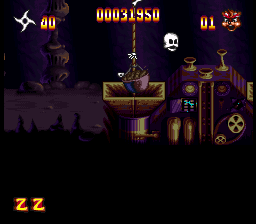
They had to earn that MA-13 rating somehow.
(And then there’s the elephant in the room of Zero’s somewhat questionable design. A character named after the infamous Japanese planes of World War II, wearing the rising sun on his head, who also performs Bruce Lee mannerisms. If the game were any more popular, one would imagine there’d be a lot more critique on this.)
Zero takes a little more after Aero’s sequel than the original game, featuring more linear levels with objectives never more complicated then reaching the end of the stage. In a marked improvement from that game, each “world” of the game only features two stages, which means none of the scenery ever goes on for too long. It’s a much faster paced game than either Aero, as well, with shorter levels that generally have a lot more going in within them. There’s still plenty of secret areas and pickups if you search the various nooks and crannies, however, which are helpful for building up reserves of health and extra lives.
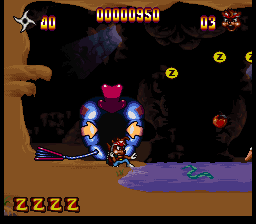
The inflatable bonus room entrances are a cute touch.
Zero has a broader range of moves than Aero had to offer, with the one similarity being that he can throw shuriken at long range. While shuriken are far more plentiful than the magic stars, the trade-off is that enemies that can block them are also far more common. Zero’s most basic move is a rolling double jump, better for gaining vertical height than serving as an attack. Your main form of offense is a horizontal swoop attack that not only deals handily with most enemies, but gives a big burst of forward momentum that helps to clear long gaps. There’s also a close-range nunchaku attack, which is useful for smaller enemies or enemies placed on platforms you don’t want to risk launching yourself off of.
There’s also one particular technique unlike anything seen in previous games, which will more than likely be a sticking point for anybody unfamiliar with the game. By pressing the dive button while in mid-air, Zero will go hurtling towards the ground, hitting anything beneath him. However, by hitting the dive button again while he’s going downwards, he’ll then turn horizontally. If you’ve built up enough speed doing a downwards dive, this’ll send Zero forward at incredible speed, letting him cross vast distances quickly. On top of that, if you press the dive button one final time while flying forward, Zero will then turn upwards and begin to rise, his speed depending on how fast you were going during the previous stages of diving.
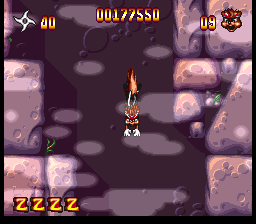
Press the button once to begin your downwards dive…
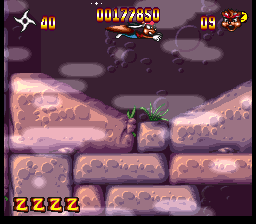
Press once more to go horizontal…
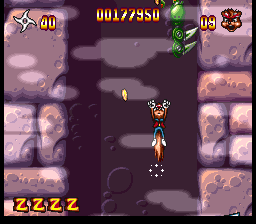
And if you’ve done it right, you’ll get a huge upwards boost out of it.
It can be a pretty complicated maneuver, and it’s not one especially well explained without the game’s manual in hand. The game makes an effort to try to break you into it slowly, introducing the idea through ‘tests’ found inside and out of various bonus rooms before expecting you to put it to use in the environments proper. If you’re not aware of how it all works, however, you’re unlikely to get very far into the game at all. Once you do learn the trick, however, you’ll start to see more and more points where you can get in a good, long dive and just blast through certain spots at maximum speed. It’s not unlike the cape in Super Mario World and the sorts of crazy stunts you can pull off, once you figure out its rhythm.
There’s a lot more movement mechanics than your average platformer, a lot of which feel especially strict in their timing. And yet there’s a lot of rewards you’ll find for figuring them out. Secret areas hidden away are common, often holding at least one extra life for the taking. You’ll also often find items dangling over something deadly, serving as a quick test to see if you’ve gotten a handle on your moves. Somewhat more tangentially, Zero can move incredibly quickly and jump incredibly high in the right circumstances, and once you figure this out, you can blow through levels in almost no time at all. This is something that has to be earned, however – the game expects you to know how it works, and if you don’t, you’re probably going to hit a wall sooner or later.
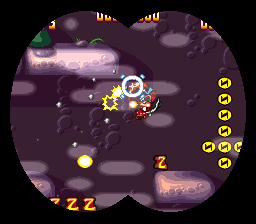
Occasionally the guy who took out Zero’s plane will take a shot at him. Thankfully, they give up pretty easily.
And yet it never feels remotely as frustrating as the original Aero, sitting comfortably at “challenging” rather than infuriating. There’s a lot of reasons for this – mostly because health usually isn’t a concern. Enemies are numerous and attack quickly, and just as often drop health when killed – and even if they don’t, pickups are usually never far away. Spikes and other various hazards are common, but thankfully won’t instantly kill you. Somewhat less common but still a problem are hazards like lava which will kill Zero dead – generally, these aren’t scattered all over the place, but generally more to make you think before making a tricky jump. Most importantly, the game offers infinite continues – run out of lives, and you’ll only restart the current stage, which means you’ll never lose too much progress.
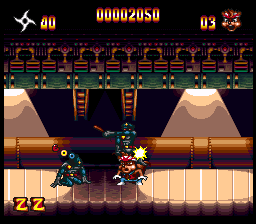
The level design doesn’t quite feel like either of the Aero games – in general, there’s a little less focus on exploration, and it feels like it relies more on its own platforming mechanics than anything else. There’s a lot less gimmickry, no searching for things to open an exit, nor will you have to play Simon to finish a stage. While the first couple of stages are full of wide open spaces to test your gliding skills in, later stages often feel a lot more cramped, making it very clear when the game expects you to go for any particularly fancy moves. The game has somewhat of a stronger emphasis on combat – there are far more enemies to deal with per level, and you’ll find yourself taking plenty of hits. There’s more boss encounters as well, with some stages even having multiple battles. While few of them particularly stand out, the game is nice enough to keep whatever damage you inflict on them between lives.
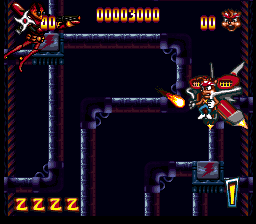
The game’s pacing is generally pretty strong – the levels are reasonably short and it’s never hard to figure out where you’re going. Even if you’re taking your time and checking for secrets, a playthrough will only generally take you an hour or two, once you’ve come to grips with the controls. There aren’t generally any roadblocks – there’s a handful of vehicle levels where you move a speedboat down a river, avoiding obstacles. Although the obstacles ahead of you are instant death, the fact that the boat’s default speed is fairly slow means that even these levels aren’t too much of a problem – or at least, not as much as that damned roller coaster from the original Aero. If there’s any particular low point, it’d be the forest levels – the scenery looks similar enough that you’ll find yourself getting turned around a lot, and the toughest dives in the game are found here – almost all of them mandatory.
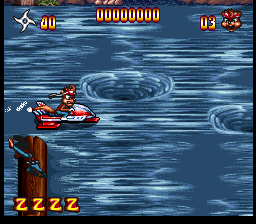
The game looks just as good as Aero 2, featuring large, colorful sprites that have a lot of character to them. Zero has just as many frames of animation as Aero did, and while he’s certainly dated nowadays, his mannerisms help give him a little extra personality. The stages also look excellent, and have that more natural, less ‘tiled’ look that really helps the game’s environments stand out against other platformers. There’s also a lot more variety in terms of tilesets, since not only are you spending as much time in each ‘world’, but some worlds even change their aesthetic between stages. The music takes a somewhat more intense, perhaps even darker tone compared to Aero 2, even featuring synth guitars to give off the required edge. It’s all generally pretty good and fits the action and themes well, even if a lot of it isn’t especially catchy.
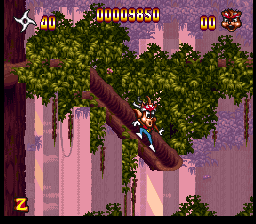
Despite a weaker back half and some mechanics that take some time to learn, Zero might truly be deserving of a cult classic. Its unique movement and fast pacing gives it an edge that neither the mainline Aero games or lesser mascot platformers ever had on offer. While it’s not quite polished enough to beat the very best hedgehogs and opposums brought forth, it’s still a game worth checking out and spreading the word of for genre fans. And for something really impressive, the speedruns on Youtube – one complete with commentary from those who worked on the game – really show off what makes the game special.
While another game in the series was promised in the credits to Zero, such a thing never came to pass. A 3D game was briefly planned for the original PlayStation, yet soon vanished. David Siller, the series producer, would go on to produce and direct games like the original Crash Bandicoot and Maximo before quietly leaving the industry. Somehow, it feels appropriate – all three games are cartoony, charming platformers that hide a fiendish difficulty. Aside from a brief appearance on the GBA, however, Aero would never return. Somehow, it feels undeserved – a promising game with brutal difficulty, a mediocre sequel, and a surprisingly good spinoff is more than Bubsy ever got, after all.
The two versions are near identical in terms of gameplay, aside from a slight difference in resolution in favor of the Genesis. The Genesis version is a little less colorful, however, which hurts it visually somewhat. While the Genesis version features have some tracks not heard in the SNES version, they come off sounding rather flat due to the use of the GEMS audio software used. The Genesis version also features an extra cutscene where Zero interrogates one of the bosses, not that it’s exactly necessary for the plot.
